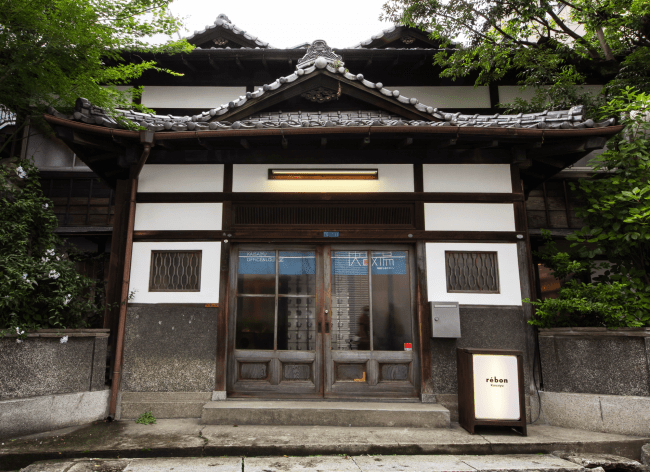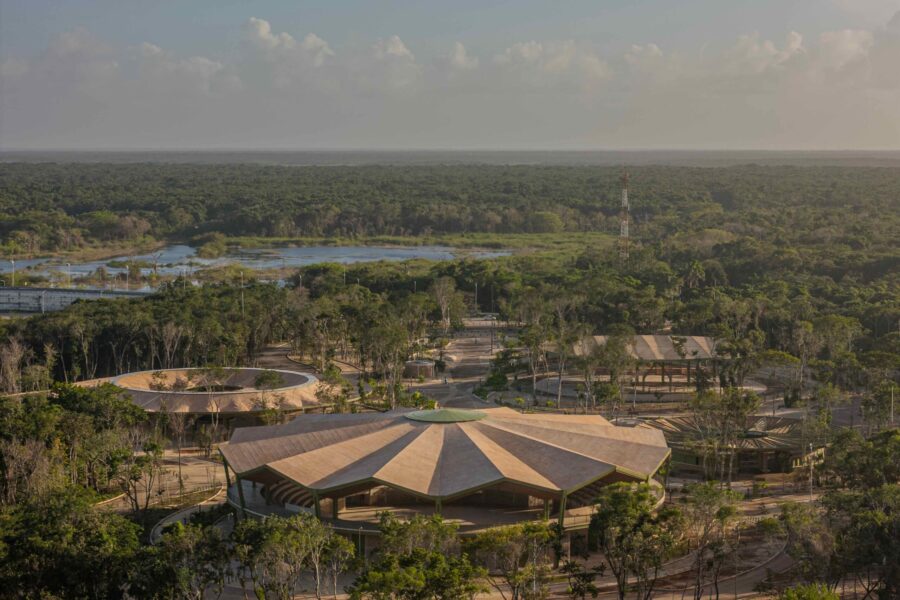
CULTURE


© Adrià Goula
〈モバイル・カタリスト(MO.CA:MOBILE CATALYST)〉は、バルセロナのクイセロラ自然公園内にあるバルダウラ研究所で製作された、「0km」の範囲から調達した自然素材とデジタル建築技術を用いた先進的かつエコロジカルなモバイルハウスです。主に集成材と布地で構成された住宅がトレーラーの上に設置されており、布とガラスの2層のファサードが活動内容や環境、ニーズに合わせて開閉することで内外の関係を調整します。
未来の建築・都市を構想し、構築することを目指す教育機関「カタルーニャ先端建築研究所(IAAC)」の高度エコロジカル建築・バイオシティ修士課程(MAEBB)の学生・研究者チームによって開発されました。
伐採から建設まで「0km」でつくるCLT建築、自然公園の間伐材というローカルな資材でつくる先進的でエコロジカルな建築〈Voxel検疫キャビン〉カタルーニャ先端建築研究所(IAAC)、スペイン
(以下、IAACから提供されたプレスキットのテキストの抄訳)

© Adrià Goula
木ダボで接合した集成材を使用した自給自足型モバイルハウス
移動民族から星間探検家に至るまで、人々は歴史を通じて、自給自足と移動を組み合わせることにより、自由という権利を得てきた。ここ数十年における自給自足の追求は、世界的な気候変動と、化石燃料に頼らずに現代の要求を満たす居住環境が必要だと認識されることによって活気づいた。さらに最近では、情報通信技術によって可能になった遠隔地での労働機会の急増や、新型コロナのパンデミックにより、移動の自由に対する関心がより広まった。
このような状況の中、MAEBBプログラムの2022-2023年度生に課された、基本的な生活設備を備えた2人用の移動式住居のプロトタイプを迅速に設計・建設するという課題から〈モバイル・カタリスト〉は誕生した。この建物は、コンサートやイベント、図書館や集会所など、内部スペースに他の機能をもたせることも、状況に応じて複数の機能をもたせることもできる。

© Adrià Goula

© Adrià Goula
自給自足のために設計されたモバイルハウス
今回の計画におけるモビリティ(移動性)という側面から、住宅はどのように移動性を活用できるのか、周囲の環境に貢献できるか、建物はコラボレーションや知識の共有を可能にするのか、という疑問が生まれた。このような考察から、ネットワーク内でリソースを接続、収集、共有する再生可能なデザインが開発された。
計画は当初の住宅という定義から拡張され、体験的な関わりを促進するもの、つまり移動可能な触媒(Catalyst)へと発展し、〈モバイル・カタリスト〉と名付けられた。
主な制限は、家を載せるトレーラーと地域の規制から生じた。トレーラーを含む建築物の総重量は3,500kgを超えてはならず(編集部註:現地の規制による数値)、最終的に長さ5.4m、幅2.4mのプラットフォームの上に高さ3.6mの家が積載された設計となった。

© Adrià Goula

Isometric diagram
さまざまな活動と設備を許容する「リアクション・チャンバー」と2つの「ツールボックス」
〈モバイル・カタリスト〉は、さまざまな活動をできるよう設計された中央の「リアクション・チャンバー」と、前後に配された2つの固定式ツールボックスで構成されている。トレーラーの前部にあるツールボックスAは、キッチン、シャワーエリア、トイレ、電気と水用のキャビネットなど、住宅に必要なユーティリティがすべて入っている。
後部のツールボックスBには、中央スペースの活性化を助けるツール等が含まれている。ツールボックスB側には入り口用のドアがあり、ファサードが閉じられている時にはメインアクセスとして機能する。このツールボックスBには特注家具を収納することができ、外に出すことで、オフィス、ワークショップ、展示会、コンサートなど、さまざまなアクティビティを開催するスペースとして活躍する。
それぞれの家具は木材、布、ダボを組み合わせた折りたたみ式となっており、軽量かつ最小限のスペースで収納できるようになっている。ツールボックスの壁は、厚さ4cmの木ダボ接合積層材(DLT:Dowel Laminated Timber)パネルでつくられており、従来の有毒な接着剤の必要性を軽減し、循環型再利用を可能にしている。

© Adrià Goula
環境や活動、ニーズに合わせて内外の関係を調整する2層の可動式ファサード
モバイルハウスの可動式のファサードは、ガラスドアとファブリックファサードという2つのレイヤーで構成されており、天候や時間帯、内部で行われる活動に合わせて、中央スペースの密閉度を調整することができる。
両側に4枚ずつ配されたガラスドアは、オープン、セミオープン、クローズと変化できるよう設計されている。閉じると中央の空間は外部環境から守られ、開くと内部と外部の境界は解消される。外層は、耐水性の綿布で覆われた軽量木材の骨組みとして設計され、紐で固定されている。長辺の2面は、滑車を利用してファサードがスライドし、折り畳まれる。

© Adrià Goula
太陽光発電と最小限の水で暮らすことのできる空間
このモバイルハウスはすべてのエネルギーを太陽から得ており、充電なしで24時間使用できるようになっている。エネルギー消費の主なものは、室内で行われるメディア関連の活動と、いくつかの基本的な家電製品である。屋根に設置された軽量の布製外皮に合わせて、3枚のソーラーパネルが設置されており、インバーターやバッテリーに接続されている。内部と外壁はLEDで照らされ、内部の明かりがテキスタイルの外壁を際立たせている。
ツールボックスの上部を活用するため、中2階には2つのベッドが設けられており、うち1つは拡張可能で、2人分のスペースが確保できる。ベッドには可動式のはしごが付属し、ベッドフレームの端に取り付けられている。

© Adrià Goula
キッチンにはシンク、1口コンロ、キッチンカウンターの下の引き出し、冷蔵庫、調理器具を吊るすスペースが設けられている。キッチンの壁には、バッテリー残量とタンク水量のインジケーターが取り付けられている。
洗面所には、水を使わない腐葉土トイレ・ボックスとシャワー・スペースがある。腐植土トイレ・システムには洗浄用の水が含まれていないため、調理や掃除で出る水以外の汚水は一切出ず、汚水の処理や廃棄の手間を省くことができる。シャワーの水は集水桝に集められ、中水タンクに貯められる。その後ろ過され、ポンプで再生水タンクに送られ、再生水システムに再導入される。水栓のハンドルは、住民が使用目的に応じて真水タンクと再生水タンクの水を切り替えられるようになっている。

© Adrià Goula

Plan

Plan

Development diagram

Isometric
以下、IAACのリリース(英文)です。
MO.CA: IAAC produces a self-sufficient mobile home made of dowel-laminated timber
・MO.CA (MOBILE CATALYST) is an advanced and ecological mobile home built using ‘zero-kilometre’ natural materials and digital construction techniques produced at Valldaura Labs in the Natural Park of Collserola (Barcelona).
・The Mobile Catalyst (MOCA) has been developed by a team of students and researchers of the Masters programme in Advanced Ecological Buildings & Biocities (MAEBB) of the Institute for Advanced Architecture of Catalonia (IAAC).
Barcelona, March 2024.
MOCA is a mobile dwelling made of 0km dowel-laminated timber produced by the Master in Advanced Ecological Buildings & Biocities programme at Valldaura Labs, from the Institute for Advanced Architecture of Catalonia (IAAC).Throughout history, people have exercised their fundamental human right to liberty by combining self-sufficiency with movement, from migratory tribes through to interstellar explorers. In recent decades, the pursuit of self-sufficiency has been energized by the recognition of global climate change and the associated need to innovate resilient human habitations that meet contemporary requirements without relying upon fossil fuels. More recently still, the surge in remote work opportunities enabled by information and communications technology and prompted by COVID-19 renewed widespread interest in freedom of movement.
In this context, the 2022-2023 cohort of the Institute for Advanced Architecture of Catalonia’s (IAAC) Master in Advanced Ecological Buildings & Biocities (MAEBB) programme was presented with the brief to rapidly design and construct a prototypical mobile home accommodating two individuals with basic domestic amenities, to be constructed entirely of 0km timber sustainably harvested from the grounds of IAAC’s Valldaura Labs facility within the Collserola Natural Park and fully processed on-site. This construction should also allow other functions in its central space, such as spaces for concerts, events, a library or a meeting place, so that depending on its context it can have multiple functions.
A mobile home designed and equipped to be self-sufficient
The mobility aspect of the brief instigated a conceptual journey bringing forth profound discussions on nomadism and collective sustenance, raising such questions as: how could a home take advantage of its mobility? Could it contribute to its immediate surroundings? Could the building allow collaboration and knowledge sharing? With these reflections in mind, a regenerative design was proposed that would connect, collect and share resources within networks.
The brief was extended from its initial definition of a home and developed to comprise an experiential engagement facilitator – a mobile catalyst – and thus the design was named MOCA. The main limitations arose from the trailer on which the home rests and local regulations. The final solution includes a platform 5.4 long and 2.4 wide on which the 3.6 m high house rests. The regulations also establish that the total weight of the construction (together with the trailer) cannot exceed 3,500 kg, and that the driver of the vehicle transporting the trailer must have Permit B96; values that became references and factors that influenced many design decisions.
The design of MOCA consists of two anchoring, solid toolboxes that contain tools and surfaces designed to initiate different activities in the central ‘reaction chamber’. The Toolbox A or Utility Toolbox is towards the front of the trailer and is the heavier toolbox. It includes all necessary utilities for a home; a kitchen, a shower area, a toilet, and a utility cabinet for electric and water metabolic systems.
The Toolbox B or Activity Toolbox contains surfaces and tools that aid in activating the central space. An entrance door is provided on the Toolbox B side. It serves as the main access when the facade is closed or otherwise. The walls of the toolboxes are made with dowel laminated timber (DLT) panels of 4 cm thickness, mitigating the need for conventional toxic adhesives and maintaining the potential for circular reuse.
The operable facade of the mobile home consists of two complementary layers – a set of glass doors and a fabric facade – that together make it possible to adapt the degree of enclosure of the central space, adapting to the weather conditions, the time of day and the activity happening within. The glass doors (four on each side) are designed to be either open, semi-open or closed. When closed, the central space is sheltered from the outside environment. When open, the interior/exterior boundary is dissolved. The outer layer is designed as lightweight timber frameworks covered with a water-resistant cotton fabric, secured with threaded cord. On the two long sides, the facade slides and folds up with the mechanical advantage of pulleys.
The mobile home obtains all of its energy from the sun and is equipped to sustain 24 hours of use without recharging. The energy consumption majorly consists of the media-related activities taking place inside and some basic home appliances. In line with the light fabric envelope placed on the roof, a set of 3 light-flexible monocrystalline solar panels connect to a MultiPlus inverter (which can also be connected to an external grid) and a battery backup. The interior and envelope are lit with LED strips, accentuating the textile enclosure with an internal glow.
Two beds (or sleeping shelves) are included on the mezzanine floor to leverage the verticality of the toolboxes (one of them extendable to two places). It comes with an extendable mattress that allows space for 2 people. A movable ladder accompanies the bed and is attached to the edge of the bed frame, which can be inclined for easier accessibility.
The kitchen includes a sink, a one-burner stove and drawers under the kitchen counter. A fridge is also provided along with spaces to hang utensils. Indicators for the battery level and tank water level are fitted at the kitchen wall. The washroom includes a waterless humus toilet box and a shower area. The humus toilet system does not include water for flushing, thus, eliminating any blackwater produced except that from cooking or cleaning. This saves the hassle of disposing of or treating black water. The shower water is collected in a catchment basin and stored in the grey water tank. It is then filtered and pumped to the recycled water tank and reintroduced to the system. The water is treated through a three-stage filter system, followed by a UV filter. The faucet handles permit inhabitants to switch between the water from the fresh water tank or the recycled water tank depending on their intended use. An inlet allows water to be pumped from external sources as well. The water from the kitchen sink is stored in the black water tank. This water is drained to external infrastructures for treatment. All water tanks are placed beneath the flooring, connected to the trailer, freeing up space for other utilities. The system works on a 12 V battery charged by solar energy, powering three circulatory pumps. Ball float sensors in tanks and a tank water level indicator have also been included for efficient maintenance.
Toolbox B features a wardrobe storing the custom furniture. When outside, the furniture activates the space to host a variety of activities, for instance an office, workshops, exhibitions or concerts. The furniture is designed to fold and to occupy minimal space in this tiny home. The design is a combination of timber, fabric and dowels making for a lightweight setup. The integrated set includes a table, 6 stools, 2 lounge chairs and 6 Fab-kits. A pair of fabric belt straps are used to secure the furniture when the mobile home is on the road. The doors of the wardrobe are made with timber and fabric. These doors are also lightweight and follow a similar design style as the rest of the furniture with the fabric being a key element. Fab-kits, stored behind the mezzanine ladder and at the entrance door, include a first-aid kit, a fire extinguisher, and space for books, footwear, laundry and other objects. Underneath, 3 entrance ladders can be stored when not in use.
About IAAC
The Institute for Advanced Architecture of Catalonia (IAAC) is a center for research, training, production, and communication, located in Barcelona with 22 years of activity. Its objective is to lead the mission of imagining the future habitat of our society and building it in the present.IAAC follows the digital revolution at all scales to push the boundaries of architecture and design to meet the challenges that humanity faces. IAAC is an experimental and experiential center where you learn by doing, through a testing methodology that promotes real solutions.
About MAEBB
The Institute for Advanced Architecture of Catalonia (IAAC) Valldaura Labs and its Masters programme in Advanced Ecological Buildings & Biocities (MAEBB) are engaged in the learning and development of ecological projects, parametric design techniques and the processing of locally-sourced materials. Valldaura Labs is known for its interest in exploring the boundaries of self-sufficiency, seeking to meet essential human needs, such as food, energy and everyday use objects, founded on the principle of a circular bioeconomy. In previous years, MAEBB students have produced award-winning projects such as the Quarantin Cabin, the Solar GreenHouse or FLORA.Project Credits
Direction: Vicente Guallart, Daniel Ibañez and Michael Salka
Academic coordination: Esin Zeynep Aydemir
Lab managers: Bruno Ganem Coutinho, Lorenzo SalinasStaff: Laia Pifarré, Pilar Fontanals, Laura Sanchez
Designed and Developed by:
The students of the Masters programme in Advanced Ecological Buildings & Biocities (MAEBB), 2022/23 class:
Austin Brown, Basant Abdelrahman, Carla Alvear Arizaga, Jacek Antoni Kostrzewa, Jackie Williams, Julia Aurora Guzmán, Larsen Bidstrup, Raffaele Schiavello, Ruhani Adlakha, Sneham Pandey, Mariano Rodriguez Alonso, Sadegh Raoufi Fard, Charles Casbolt, Aishwarya Balsekar, Disha Arora, Indraneel Joshi, Laila Nabulsi, Nicolas Rotta, Nishanth Maheshwaran, Pradyumna Vikharankar, Prati Jain, Rujuta Chauhan, Shruti Sahasrabudhe and Santwana MalakarProjectHost: Valldaura Labs of the Institute for Advanced Architecture of Catalonia
Sponsors: Luz Negra, Tallfusta
With the support of: Parc de Collserola
Advised by: Jesus Bueno, Jochen Scheerer, Miquel Rodriguez, Thatcher Bean
Photography: Adrià GoulaSocial Media IAAC
Instagram: @iaacbcn
Linkedin: @institute-for-advanced-architecture-of-catalonia
X: @iaac
Facebook: @Iaac.BCN
YouTube: @iaacat
IAAC 公式サイト









